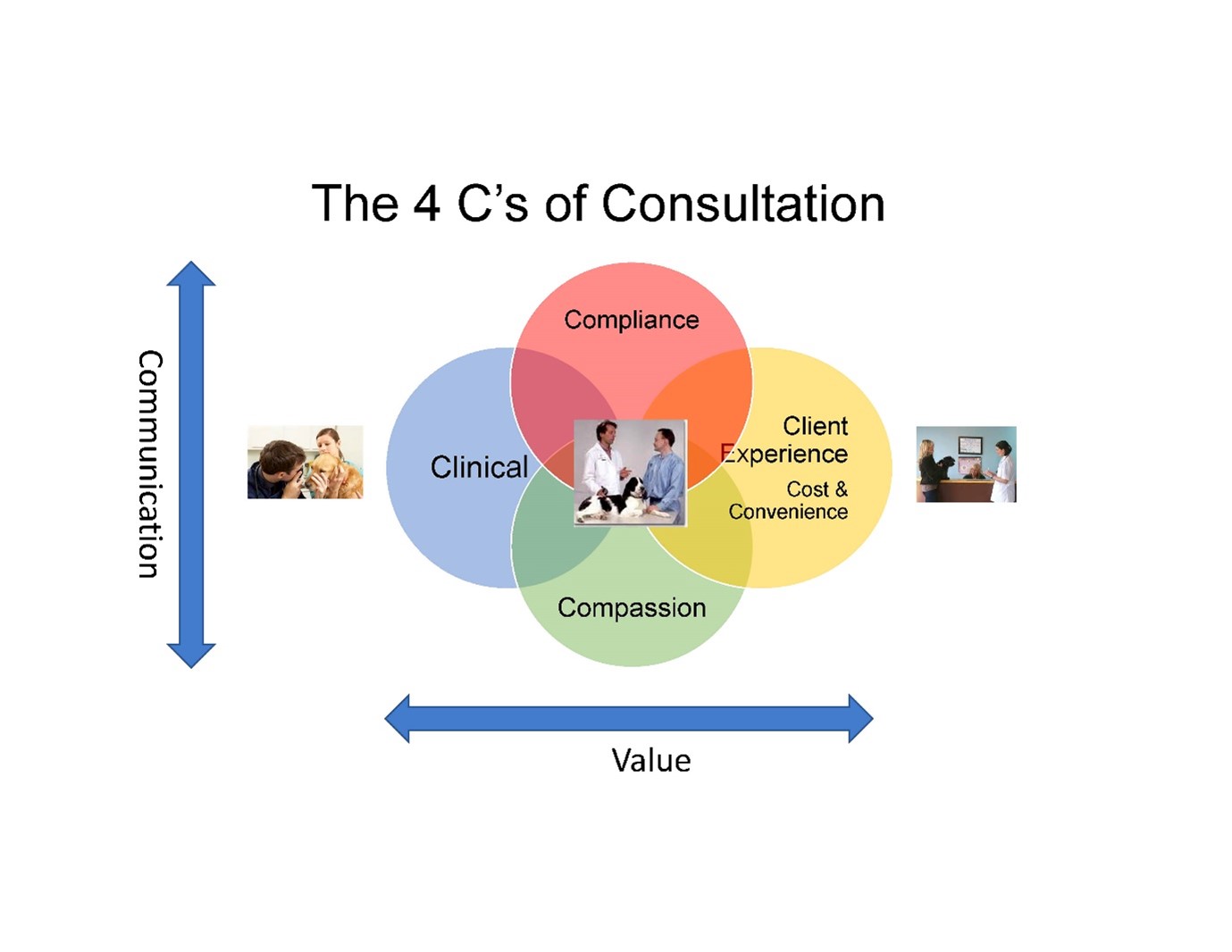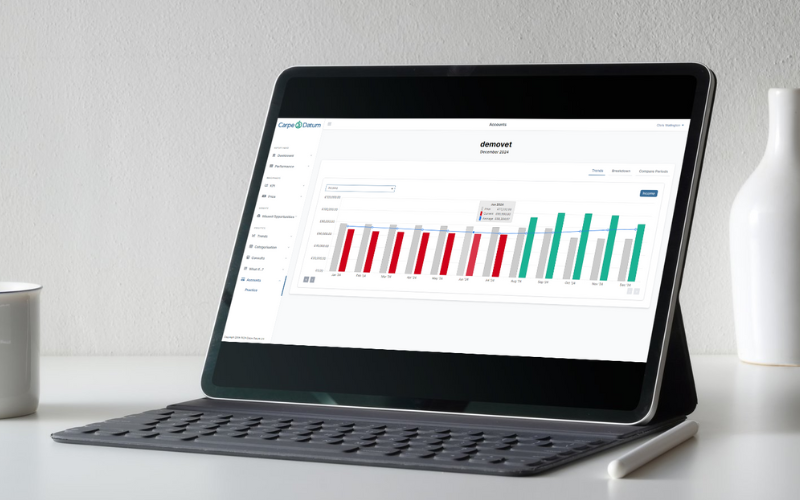Good clients can be described as clients who comply with your recommendations for the benefit of the pet. Managing client compliance is the secret to a high performing and profitable practice. High compliance means that you create, better patient outcomes, better work and revenue from far less clients. The secret to improving client compliance is to remove the real and perceived barriers to high client compliance.
To optimise the opportunities from each consultation we need to measure and monitor performance per practice and per vet, set accurate pricing including professional time and have systems to manage the outcomes of any consultation.
The Consultation
During COVID restrictions the veterinary consultation is taking longer but often inefficient, rushed and not focused on the four outcomes necessary for good veterinary business. Typically, vets are already busy and running late, so they rush people or pet in from the carpark, jump into the clinical exam, trying to diagnose as soon as possible, instigate treatment and diagnostic procedures then move on to NEXT consultation…
Does this add value from the clients’ experience and what are the missed opportunities? Typically we see:
- Discounting professional time – selling yourself at too low a rate and not charging for everything you do – giving it away
- Not listening to the clients’ concerns with empathy and compassion
- Failure to recommend treatment – not doing the work presented and needed
- Failure to practice good protocols and not following up case work appropriately
The ‘4 C’s’ of Consultation
Every clinical consultation has 4 clear outcomes and processes to achieve –
- The Clinical care of the sick animal – this is the vet’s responsibility to diagnose and recommend the most appropriate treatment
- The Cost Incurred by the recommended treatment is the client’s problem – not yours. You need to charge correctly you could elevate this (bad) or offer a solution like Carefree Credit. You could help by providing an earlier estimate, help them process. If they cannot afford you may have to adjust your clinical input!
- Compliance needs certain things done at a certain time for the pets benefit – medication, bandages change etc. This is a shared responsibility, and you need to negotiate between you. ‘I’ll do this, and you’ll do that’ This takes time and careful communication
- Compassion is the emotional content of the consultation for the pet, the client and the vet. This is a shared responsibility and clear boundaries on both sides are required, particularly in difficult cases and end-of-life decisions!

All this involves communication! In a rushed 15-minute consultation this will not happen even with 20 minutes will struggle! These 4 outcomes require some framework to be successful.
- Clinical outcomes
The client consultation process, whether it’s a once-only visit or a series of discussions over treatment, is the core to the relationship with your clients and their pet’s welfare. Honouring the relationship between owner and their pet cannot be understated.
However, there is an estimated 55% compliance gap between what is presented in a consultation room and what is treated. This poor clinical compliance from a veterinary perception is due to:
- Cost – the vet deciding that the client will not or cannot pay for the recommended treatment because the treatment is too expensive, therefore not making the appropriate recommendation in the first place.
- Communication and client education – even when the vet does make a recommendation it can be unclear and ambiguous, providing too much information in a short time, causing confusion and uncertainty, giving too many options without a definitive recommendation, lacking conviction as the most appropriate action or not explaining the benefit of the recommended treatment.
- Perceived value – the client not seeing the value in regard to the treatment process or prognosis of the case – or even seen as ‘profiteering’ with unnecessary work.
- Client time and convenience – having to come back or scheduling at a time inconvenient to the client
- Process error at the clinic – failure in processing the payment, scheduling treatments, reporting results or booking follow-up appointments
Because of this lack of effective recommendation from the vet, the client won’t know what to do or will be confused about the options available.
Here are some tips to improve communication:
- Ask Open Questions (requesting further information) rather than Closed Questions (Yes/No binary answers) to gain clarity about the clients understanding of the condition and the recommended treatment
- Differentiate the ‘disease’ – the pathology in the patient- from the ‘illness’ – the emotional perceptions about the condition in the clients’ mind. There is a fundamental difference – the animal has a pathological condition (disease) that can be treated; however the client has a sick animal causing anxiety (illness) that needs reassurance.
- Be very clear about the need or benefit as to why the procedure is necessary. Vets want a diagnosis, but clients want a prognosis –– explaining what the outcome is rather than what is the clinical label of the problem.
- Need or benefit not explained – told but not explained the need or the benefit – for example – the benefits of the Urine Test – does it help the diagnosis or the prognosis, or both – if it does not add to the prognosis, it may not be worth doing.
- Following Protocols – One vet says one thing another says something different, criticising other vets opinions or ends up booking in for a different procedure.
- Lack of reinforcement by veterinary team – following systems and protocols to get to a resolution by agreeing consistent practice protocols – a follow-up system for the outcomes of any consultation.
For any consultation there are only 4 possible outcomes that require backup systems. The 4 main results are:
- The pet is healthy, and the client is educated, therefore return the pet to the preventative healthcare system
- The pet requires long term medication, therefore put on a chronic medication programme
- The pet requires admission for sedation or anaesthetic, therefore invoke an admission, hospitalisation and discharge process
- The pet requires euthanasia, therefore invoke the euthanasia and bereavement process
There are two sorts of vets – those who have systems and those who don’t. Who is more effective?
- . Client compassion comes at a price. Veterinary compassion costs time, energy & money. We need to practice compassion as professionals however compassion has value to the client and comes at a cost to the vet. Therefore, we charge to provide compassion. Vets can show compassion in four key ways when interacting with the pet and the client.
-
- Alleviate and avoid causing any more perceived pain in the pet through handling and examining.
- Offer a prognosis rather than a diagnosis – what is the likely outcome for the pet
- Explain the treatment process and show understanding of the compliance difficulties the client may have.
- Agree a clear, fair and unambiguous price for the treatment as far as you can.
There are two types of vet. One that needs to make the ‘RIGHT’ diagnosis and one that sees a clinical and emotional ‘challenge’ that needs resolution. Who delivers better value?
- Financial compliance to maintain a profitable and sustainable business. Financial compliance occurs when the vet team ‘bills and banks’ 5 times the cost of their employment, therefore all procedures need to be
- Priced accurately and clearly
- Recommended to and agreed by the client
- Invoiced fully at the time of treatment
- Paid for easily and at the time of treatment
“The £75 Rule” – The Cash conversation in the consultation
Clients do not look at your ‘Consultation fees’. Clients have a ‘Go to the Vet’ expectation threshold figure in their head …… £75-£85-ish = Consultation + drugs + injection
If your consultation total cost does not exceed the expectation threshold (~£75.00) you probably do not have to talk about money….
HOWEVER…
If your Consultation total cost does exceed this threshold you MUST talk about cost or provide an estimate. DO NOT, I repeat, DO NOT leave this problem to the receptionist!
- Team harmony. Successful practices focus on maintaining high levels of trust & flow in their teams. Do not disrupt the rest of the team just because you can’t be bothered to do your job properly. Therefore, all team members need to keep the following in mind:
1. Consideration for others – do NOT make their job harder!
2. Compliance – follow agreed practice protocols and procedures
3. Communicate with each other
4. Completion – finish your job to the required standard
“The Bermuda Triangle” – (courtesy of Brian Faulkner) – The space between the consulting room door and the reception desk where clients and cash disappear… There needs to be a system for information to transfer from the consult room and the receptionist. We use the analogy of a relay race – who is holding the baton. With the baton goes the “4 Cs” of information:
- Clinical – what’s the problem we are resolving
- Compliance – what we have to do
- Compassion – what are our concerns
- Cost – what’s it going to cost
Initially the receptionist holds the baton (client and pet). The vet picks up ‘the baton’ from the receptionist to the consulting room. The vet returns ‘the baton’ to the receptionist and relay the information to the receptionist. You should never drop ‘the baton’
In summary here are 10 tips for adding value to the consultation to improve compliance, maintain team harmony and deliver quality clinical care.
- Be willing to calculate and charge a fair price for your professional time.
- Aim to be professional and respected first – and liked second! – Practice good medicine.
- Learn to live with price queries it is usually an indication of confusion rather than rejection. Use the ‘£75 Rule’
- Vets need a diagnosis – what’s happening now. Clients want a prognosis – what’s going to happen next – Offer the best options to get the best prognosis first
- Don’t assume clients can diagnose and prognose. Get cases back physically or remotely for you to examine
- Deal with the ‘illness’ – not just the ‘disease’. Ask open questions and involve the client
- Don’t use jargon or technical terms that a non-vet can’t understand
- Adhere to agreed ‘best practice’ protocols and agreed best products
- Use digital or text information handouts for improved compliance
- Take more time – do better work – minimum of 15 -20 minutes consults and use your nurses





